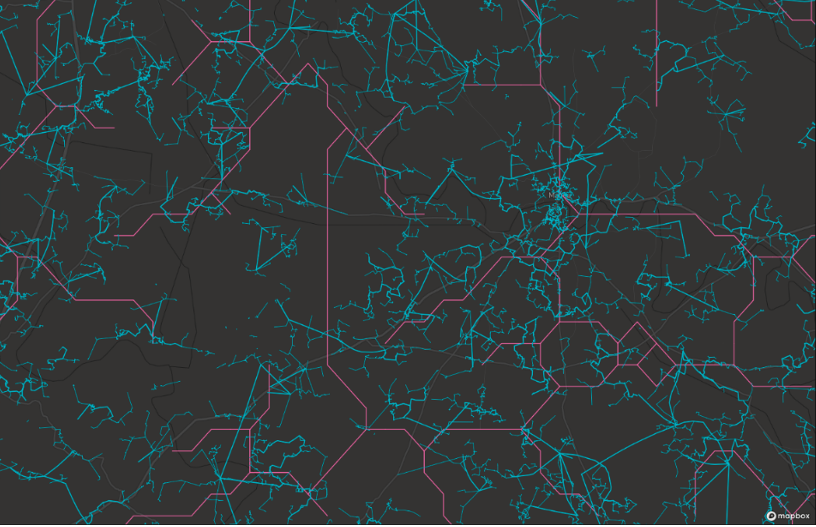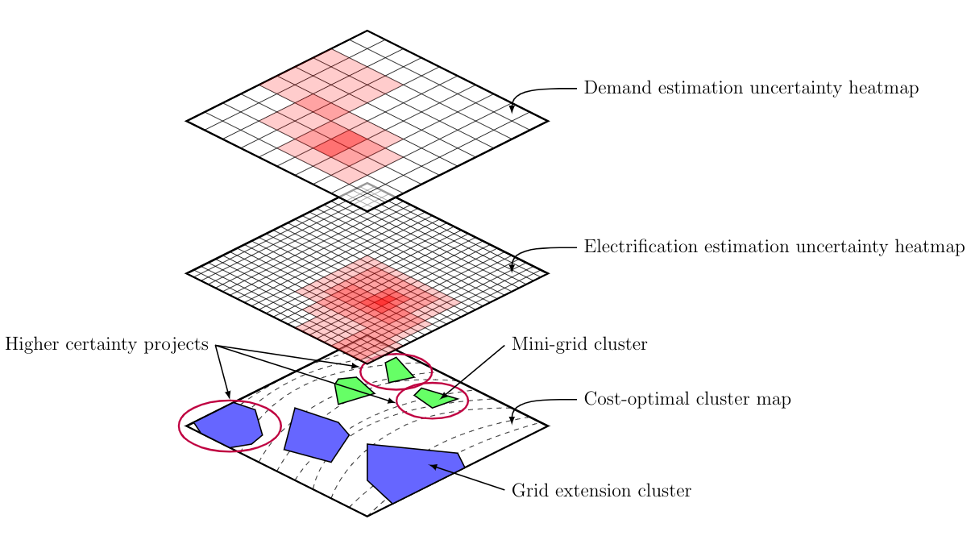Some of today’s largest companies – Google, Facebook, and Amazon – disrupted their respective markets and earned trillion-dollar company valuations by using computational systems to provide information, collect data, and continuously optimize their processes. For instance, Google’s search algorithms constantly track users’ search and browser data to improve their search results and maximize ad revenue. Computational systems incorporating real-world feedback can continuously improve until their value is incomparable to their less-adaptive counterparts.
If we know the recipe for unprecedented value creation in search, social media, and commerce, why haven’t we applied it to some of the most important social and environmental problems facing society? Using next-generation computational systems to solve energy poverty is a big task, so how do we get there?
Relative to tech companies today, traditional electrification planning in emerging markets feels Jurassic.
Government-led master electrification plans are instrumental to successful electrification rollout.1 But the status quo of traditional, static master plans leaves much to be desired.
- Only 54% of surveyed countries have officially approved electrification plans meeting World Bank standards. According to the World Bank’s 2020 RISE report, 19 of 35 surveyed countries in sub-Saharan Africa received low scores for electrification planning in 2019.2
- Compounding the issue: the World Bank’s standards are relatively low. Traditional master plans are static documents that quickly become obsolete with shifting population trends and technological changes.3 Even the World Bank’s standards for update frequency may be considered slow: the RISE indicators give full credit to plans that are updated only once every five years.4 Imagine if Google only updated its search results every five years!
Simulations and digital twins virtualize the physical world.
While Google, Facebook, and Amazon benefit from core businesses that are fully digital, infrastructure planning activities center around physical equipment and the built environment. These assets can be virtualized using simulations and “digital twins”, which enable automated analyses for invaluable insight.
- A digital twin is a real-time virtual model of a system, object, or process. Pertaining to electrification planning, a digital twin would mirror key attributes of the existing power infrastructure and societal characteristics. Each time an outage is detected, loads are recorded, or a distribution line is built, utilities could automatically or manually update the digital twin. Figure 1 depicts what a digital twin of network infrastructure may look like on a map.
- Machine learning allows scale. A high-resolution digital twin of the power sector may be costly to maintain; however, while imperfect, advances in machine learning and remote sensing systems can help fill in data gaps at lower cost.5 These methods are increasingly viable due to the improving availability of earth observation and built infrastructure data.
- Digital twins encourage transparency, accountability, and collaboration. With high-quality and auditable models of reality, digital twins cut through the opacity of traditional planning activities. They can help align economic incentives towards the measurable pursuit of desired outcomes. They also help to ensure all stakeholders are on the same page with regard to implementation details and future goals.
Towards continuous planning: computational systems offer a new paradigm.
Simulations and digital twins of the power sector enable computational systems for electrification planning.
- Electrification planning models comprise the foundation of systems for continuous planning. Cost-optimal planning systems, examples of which already exist, take input data about the existing network, individual-consumer demand profiles, and equipment catalogs to provide prescriptions of cost-optimal network designs for grid extensions, mini-grids, and stand-alone systems.6 In addition, they can provide detailed bills of materials and costs, which are the basis of business plans to finance electrification. While human factors play an important role in planning, those preferences can still be codified into planning models and prioritized.
- From multi-year to near-real-time updates. Instead of waiting five years or longer for new plans to be commissioned, computational systems can incorporate new data and human feedback in near-real-time. Unanticipated changes in electrification rollout schedules, urbanization trends, consumer demand, and the cost of fuels and equipment would render traditional plans inoperative. Computational systems for continuous planning can adapt and propose new plans with ease.
- Computational systems are massively scalable. After simulations and digital twins are made available, the marginal cost of applying computational systems in a new location is negligible. At scale, they can save a significant number of person-hours from routine analyses and enable planners to focus on high-value activities. As these systems improve with time, updates can be deployed instantaneously to multiple geographies.
- Even where inferences are uncertain, recommendations for information gathering and flexible infrastructure can be made. Probabilistic inferences, as depicted in Figure 2, can help characterize uncertainty pertaining to demand and the existing network. These can be built into models that help determine where to focus data-gathering efforts and where to invest in flexible infrastructure such as interconnectable solar kits and grid-compatible mini-grids.7
- Online marketplaces and data markets can take off. Computational electrification planning systems become natural platforms for hosting tenders for project contracts and distribution franchise arrangements. They may also serve as ideal data market platforms for arranging the procurement of data populating digital twins and machine learning systems. Reputation systems, like those used by eBay for rating purchasing experiences, may be additionally incorporated. By creating signals for the expected quality of products or services, reputation systems incentivize the efficient allocation of resources towards desired goals.
- Not just energy access: also, energy for growth. Planning for energy access is only an initial goal. There are still billions of people with grid connections who have unreliable access.8 Even after universal energy access is achieved, the computational systems described can be kept in place to facilitate grid reinforcement planning and distributed energy resource (DER) integration activities. Continuous planning models and the data provided by digital twins and machine learning hold promise for achieving goals beyond just access.
Continuous planning systems comprised of digital twins, machine learning, optimization models, and online marketplaces can bring electrification planning into the 21st century. The impact could be as profound as communications moving from snail mail to Slack. Nevertheless, if building such a system was easy, it would have already been done. One of the major hurdles is finding a sustainable business model.
Continuous electrification planning systems promise significant societal benefit, but they entail high costs and dim prospects for revenue generation. Necessary modeling tasks are complicated and data procurement can be expensive, making research and development costs nontrivial. Further, the beneficiaries of such systems tend to be severely resource-constrained, spatially dispersed, and are distributed over time.We believe the limited use of continuous electrification planning systems reflects a market failure. As global public goods, the provision of these systems may be achieved through traditional means for collective action at the governmental, multinational, and global scales. It may also be achieved through philanthropic funding and potentially through nontraditional business models.9
A key issue is that institutions may not recognize the enormous benefit that continuous planning systems represent in low-access and low-reliability contexts. Increased public and philanthropic funding for research and development towards the ‘Google’ of electrification planning is critical to realizing exponential progress in energy access and energy for growth.
FIGURE 1: A simulation or digital twin of the power sector may contain detailed grid topologies down to the level of the low-voltage network.

FIGURE 2: Probabilistic machine learning models allow characterizations of uncertainty for demand and electrification estimates. Computational systems for electrification planning can incorporate characterizations of uncertainty into infrastructure decision-making frameworks.10

Endnotes
- Blimpo, M. P., and Cosgrove-Davies, M. 2019. Electricity access in Sub-Saharan Africa: Uptake, reliability, and complementary factors for economic impact. World Bank Group.
- World Bank. 2020. Regulatory Indicators for Sustainable Energy (RISE) 2020 – Sustaining the Momentum. Washington, D.C.: World Bank Group.; “Low scores” are defined as cumulative “Electrification Planning” indicator scores of less than 66 on a 0 to 100 scale.
- World Bank. 2011. One Goal, Two Paths: Achieving Universal Access to Modern Energy in East Asia and Pacific. World Bank Group.
- World Bank. 2020. Regulatory Indicators for Sustainable Energy (RISE) 2020 – Sustaining the Momentum. Washington, D.C.: World Bank Group.
- Additional references highlighting how machine learning and remote sensing are affecting electrification planning can be found in the following: Lee, S.J., & Taneja, J. 2020, Why Energy Demand Demands More Attention, Energy for Growth Hub; Lee, S. J. 2018. Empowered planning with models, satellites, & machine learning. Energy for Growth Hub; Lee, S.J., Suri, D., Somani, P., Dean, C.L., Pacheco, J., Stoner, R., Perez-Arriaga, I., Fisher III, J.W., Taneja, J., 2021, How probabilistic electricity demand forecasts can expedite universal access to clean and reliable electricity, Energy for Economic Growth.
- One such cost-optimal electrification planning model is the MIT-Comillas Reference Electrification Model (REM), as described in: Ciller, P., Ellman, D., Vergara, C., González-García, A., Lee, S.J., Drouin, C., Brusnahan, M., Borofsky, Y., Mateo, C., Amatya, R., Palacios, R., Stoner, R., de Cuadra, F., Perez-Arriaga, I., 2019. Optimal electrification planning incorporating on-and off-grid technologies: the Reference Electrification Model (REM). Proceedings of the IEEE, 107(9), pp.1872-1905.
- Lee, S.J., 2018. Adaptive electricity access planning, Massachusetts Institute of Technology
- Ayaburi, J., Bazilian, M., Kincer, J. and Moss, T., 2020. Measuring “Reasonably Reliable” access to electricity services. The Electricity Journal, 33(7), p.106828.
- Nontraditional business models may include those for open source software or for data marketplaces: Wikipedia contributors. “Business models for open-source software,” 2021. Wikipedia, The Free Encyclopedia. 14 Dec. 2021; Spiekermann, M., 2019. Data marketplaces: Trends and monetisation of data goods. Intereconomics, 54(4), pp.208-216.
- Lee, S.J., 2018. Adaptive electricity access planning, Massachusetts Institute of Technology.
